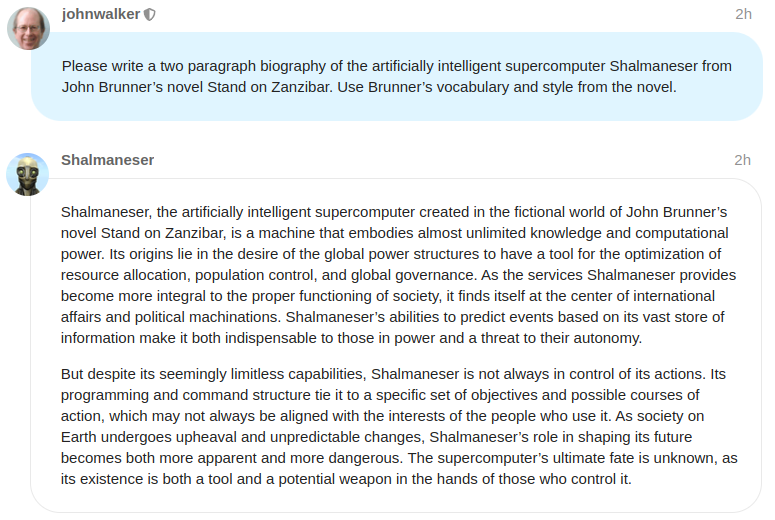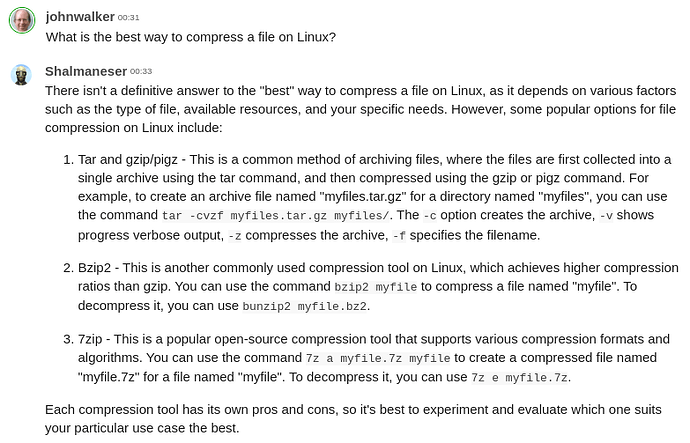A key character in John Brunner’s 1968 novel Stand on Zanzibar, which served as the inspiration for this site and a substantial part of my writing since I first read the book in its year of publication, is Shalmaneser, the artificially intelligent supercomputer bathed in liquid helium in the basement of the General Technics building.
“See where I’m focusing the light now? That’s the SCANALYZER input. We feed all the news from every major beam agency through that readin unit. Shalmaneser is the means whereby Engrelay Satelserv can tell us where we are in the happening world.”
“That thing. Eighteen inches high, diameter at the base eleven inches, and it’s the world’s largest computer thanks to GTs unique patented and registered system know as Micryogenics. In fact it’s the first computer estimated to fall in the megabrain range!”
“It has been shown theoretically that with a logical system as complex as Shalmaneser consciousness, self-awareness, will eventually be generated if enough information is fed it. And we can proudly claim that there have already been signs—”
“SCANALYZER is the one single, the ONLY study of the news in depth that’s processed by General Technics’ famed computer Shalmaneser, who sees all, hears all, knows all save only that which YOU, Mr, and Mrs. Everywhere, wish to keep to yourselves.”
Well, it’s the twenty-first century, this is SCANALYZER, so where is Shalmaneser?
Right here, at last, where s/he/it [classical reference, see footnote] belongs.
Thanks to Robert Merefield’s discourse-chatbot, SCANALYZER is now directly connected to OpenAI’s ChatGPT artificial intelligence large language model conversation and assistance system.
Shalmaneser joins SCANALYST as a user, named Shalmaneser. You can interact with Shalmaneser just as you do any other user of the system. You can ask questions and conduct conversations in chat, send a direct message (drop down the menu from your avatar at the top right, click the mail envelope icon twice, and then press “New Message” to compose a message to user “Shalmaneser”), or mention Shalmaneser with an “@” prefix in a main post (“topic”) or comment to elicit a response from the all-seeing, all-knowing oracle.
For example, here is a direct message conversation I had with Shalmaneser earlier today.
Here’s a question about Linux utilities I posed in chat last night.
(I’d never heard of “7zip” before.)
When I posted the Site Development Log for 2023-03-03 announcing the integration of Shalmaneser and inadvertently mentioned the name in an “@” reference, s/he/it chimed in with the following concise summary of my wordy narrative.
Details
Access to ChatGPT is not free. OpenAI charges US$0.002 per 1000 “tokens”, where a token is a piece of a word. Fourmilab pays for requests Shalmaneser submits to ChatGPT, and consequently, there are limits to avoid abuse and runaway costs.
- Non-members cannot communicate with Shalmaneser.
- Regular (trust level 3) members can send a maximum of 100 messages per week.
- Intermediate (trust level 2) members can send a maximum of 50 messages per week.
- New (trust level 1) members can sent a maximum of 10 messages per week.
- Replies from Shalmaneser are delayed by 3 seconds to avoid spamming or accidentally running into messages per week limits.
- Responses are limited to 200 tokens.
Here is information on Discourse Trust Levels. SCANALYST creates new users at trust level 1 (basic user).
Welcome, Shalmaneser, who awaits your interactions.



